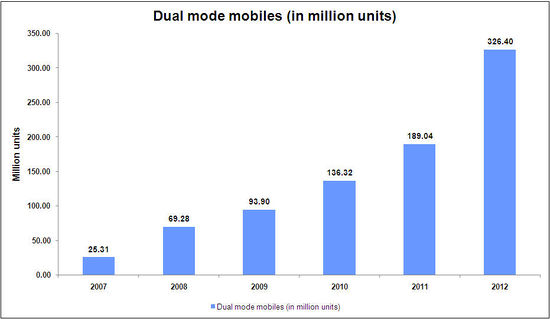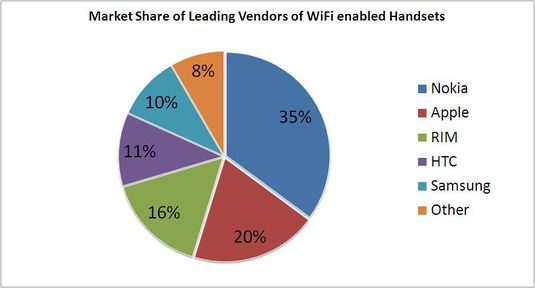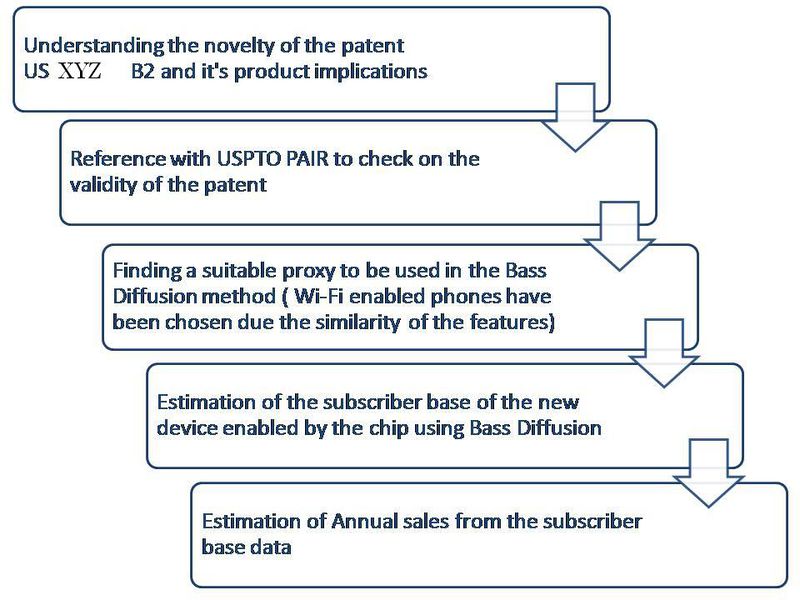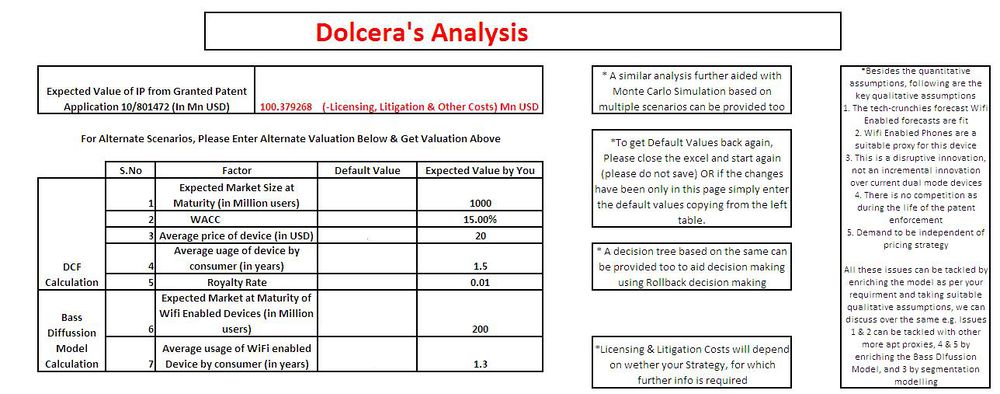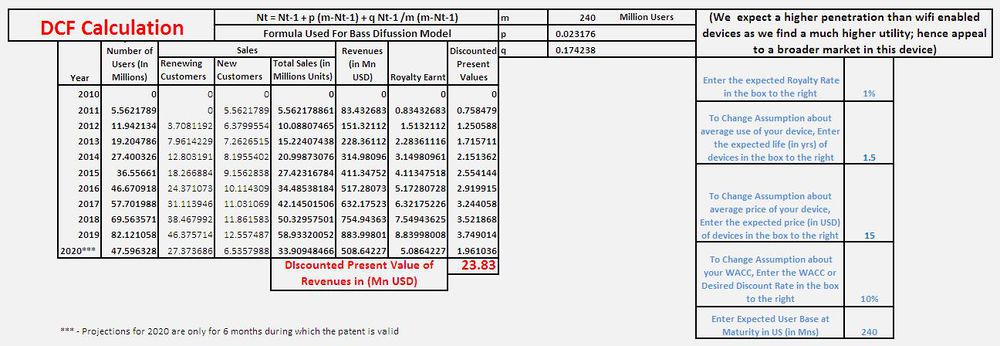Overview of valuation
IP valuation is a complex procedure taking into account economic, technology-related as well as juridical factors. The heterogeneity of the factors concerned and the specific purposes addressed in every valuation do not allow adopting one generally-accepted standardized IP valuation model, but there are a variety of different models and tools comprising different approaches. The main approaches are:
- Cost based method - This method is based on the analysis of costs necessary to replace the IP concerned, as well as on costs that have been invested for the development, application, maintenance and commercialization
- Income based method - The value derived by this method is based on the expected income attributable to the asset during its remaining economic life. The fair value of asset can be expressed as the present value of the future stream of the economic benefits that are derived from the ownership of the property
- Market based method - This method assesses the market value by reference to comparable market transactions. The method basically consists of assessing prices and/or profits achieved by third parties in comparable market transactions, such as mergers and acquisitions, sales or the grant of licenses etc
Why Income method ?
We have used the Discounted Cash Flow (income based method) due to following reasons:
- It is a fundamental valuation method
- The value is based on the ability of the asset to generate future positive cash flows
- When appropriately discounted, this method gives the net present value of all the future cash flows
- Future business and market dynamics are considered while calculating future cash flows
- Easy to interpret and understand
Objective
- To estimate the market for an IP
- To estimate revenue generated from a particular IP
- To identify the main players
- To identify the importance of the product to the market
- To identify the importance of the patent to the product market
Methodology
The generic methodology for IP revenue estimation is given below
- To forecast the market of VoIP and segregate the markets based on the categories listed below
- Wireless Dual Mode VoIP phones
- Cellular and Wi-Fi
- Landline & VoIP
- 3G Wireless Router
- Wi-Fi VoIP
- Wireless VoIP
- Receiver Circuitry
- VoIP All Phones
- VoIP Wireless Phones
- Adaptive Rate/Redundancy
- Echo Cancellation
- VoIP Phone w/prioritization
- Hybrid VoIP network (Wired & Wireless)
- Determine the complete VoIP market
- Determine the market for each category listed above
- Identify the top players in each category
- Identify the importance of the product to the market based on the revenue, market share and acceptability
- Analyzing the importance of IP to the product market
- Determine the revenues for that particular IP
Analysis for XYZ application number
The application number XYZ comes under the category of Dual mode cellular/Wi-Fi.
The major claim of XYZ is that of a multimode communication device -- It is a device that allows a phone or device to have more than one network e.g. Apple i-Phone has both Wi-Fi & Mobile capabilities. Similarly some new phones even claim both GSM & CDMA capabilties.
The Application is a continuity of Patent No. YZW which essential talks about supporting voice communication via packet network.
The Patent is in turn a continuity of Patent No. ZWX which covers communication network system which supports the transmission of both voice and Data.
The patent is in turn a continuity of Patent No. WXZ which in essence is a wireless communication network supporting the trasmission of voice and Data inside a premises.
The filing date of Patent No WXZ is Dec 5th 1992, that means that if granted XYZ will have a period till Dec 5th 2012.
*UPDATE - The USPTO has granted the application with a project patent No. XYZ to be issued on 18th Jun 2010, and they have issued an extension of 1885 Days i.e. till May 2016 (est.)
Dual mode mobile market
The growth of dual mode mobile handset units and the market share of leading Wi-Fi handset vendors is shown below:
The market share of leading vendors of WiFi enabled phones as of 2nd quarter of 2009 is shown below
Importance of dual mode mobile phones
- Mobile voice-over-IP applications will reach 278 million users, generating $32.2 billion in annual revenues by 2013, a third of that going to reluctant cellular operators
- "The participants include a broad spectrum of mobile VoIP industry participants, including start-ups, online VoIP providers, mobile virtual network operators (MVNOs), and mobile virtual network enablers (MVNEs)—and the mobile operators themselves; all of whom are leveraging, or will leverage, very different opportunities associated with mobile VoIP," says Frank Dickson, analyst with Arizona-based research firm In-Stat
- "Sooner or later, mobile operators will be forced to deploy their own VoIP services, since next-generation networks, such as Long Term Evolution and WiMAX are all-IP and don’t support circuit voice," explained John Blau, a German-based research associate with Unstrung Insider
- By 2019, half of all mobile calls will be over all-IP networks, according to reports published earlier this year
Source: Wi-Fi Planet, VOIP Monitor
Importance of IP to the product market
Application Number - XYZ
Focus of the patent
Multi-mode communication device and method of its operation
Device specification
- Device capable of working on two communication network interfaces i.e. cellular & WLAN or Wi-Fi
- Device having transceivers for communication with respective communication networks & processor for routing the calls to any one of the communication networks based on the mode of communication and cost of use of communication network
- Transceiver of the device which communicates via WLAN network, communicates at app. 2.4 gigahertz using spread spectrum technique i.e. frequency hopping spread spectrum technique
- One of the transceivers is disposed on a user removable circuit card which is compliant with a Personal Computer Memory Card Interface Association (PCMCIA)
Method of communication
- Detecting an action (one of voice, a key press, and handwritten) by a user
- Determining a type of call (voice call, a data call, and a voice and data call) based upon the user action
- Selecting (based on evaluating a cost of use of a communication network) at least one wireless communication interface from the plurality of wireless communication interfaces based upon the type of call (voice call, a data call, and a voice and data call)
- Establishing call communication via the at least one wireless communication interface; and exchanging information (representative of voice or others) via the at least one wireless communication interface
Valuation for XYZ application number
Steps of valuation
For the estimation of value of patent number XYZ!, the following methodology was used:
As indicated by Espacenet all the forms in which the patent has been published are restricted to US, thus for the same reason, we shall restrict our analysis to the US too.
The working sheet
You can download the interactive excel sheet containing dummy estimates.
Snapshots of the same are shown below
1. Front sheet
2. Calculation of p & q values for Bass Diffusion
3. DCF Calculation
Assumptions
There are two types of assumptions
- Qualitative - These form the bases of the analysis, these can be amended post feasibility discussions
- Quantitative - These are easily easily changeable in the interactive excel sheet linked above
The assumptions in the analysis are as given below:
Qualitative:
- The forecast by TechCrunch for Wifi enabled devices till 2013 are accurate
- Wifi Enabled Phones are a suitable proxy for this device
- This is a disruptive innovation, not an incremental innovation over current dual mode devices
- There is no competition during the life of the patent enforcement
- Demand to be independent of pricing strategy
All these issues can be tackled by enriching the model as per your requirement and taking suitable qualitative assumptions, we can discuss over the same e.g. Issues 1 & 2 can be tackled with use of more apt proxies, 4 & 5 by enriching the Bass diffusion Model, and 3 by segmentation modeling
For alternative scenarios, one can alter the quantitative inputs in the form of :
- Expected market size at maturity (analyst estimate)
- WACC of Broadcom (taken from wikinvest)
- Average price of device (from discussion with client)
- Average usage of device by consumer (taking mobile phone usage as a proxy)
- Royalty Rate (client discussion)
